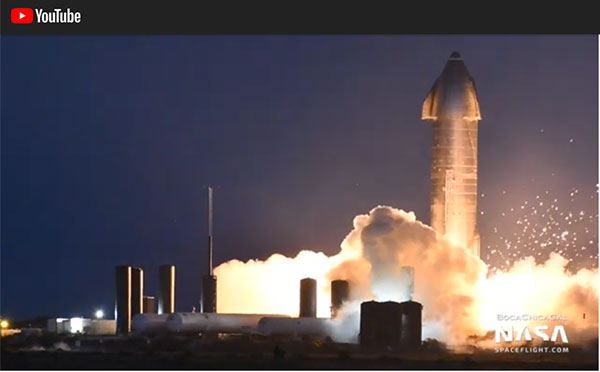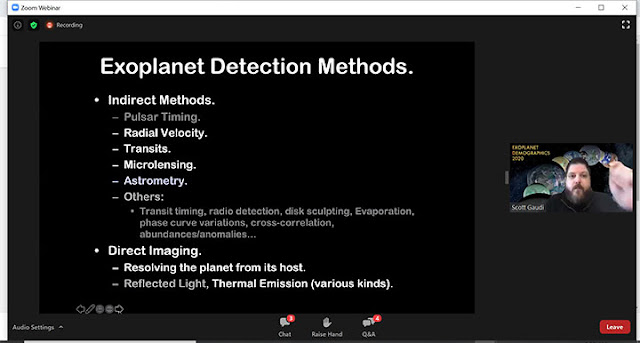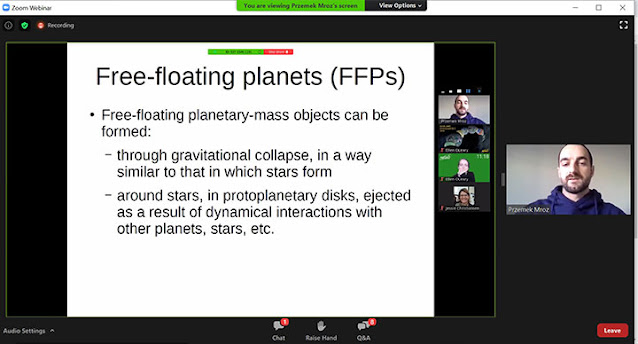Greetings from Palmia Observatory
Well here we are just settling in for a week long series of meetings at the online version of Exoplanets Demographics 2020, where we learn all about what is being learned by the ongoing study of all of the exoplanets that have now been discovered, but before that we have a bit of Starship SN8 news.
This image of Starship SN8, from @BocaChicaGa, Mary, shows one of the static fire tests. When you watch the video you can see the engine ignition and then about 5-6 seconds later, which means about 1 mile away, the video shows the camera shaking and vibrating and the large booming sound of the engine(s) firing for just about a second. Pretty Neat! So, we guess that maybe another static fire test will be performed and then the test hop. Wow, I sure would like to be in Boca Chica for that. I think air travel and hotel travel is an acceptable risk but I am reluctant to put Resident Astronomer Peggy and observatory staff at risk, just to fly off and witness a rocket launch. So, I guess we just have to wait for Mary to fill us in on the ongoing testing. Thanks for being there, Mary!
 |
Starship SN8 static fire test at SpaceX Boca Chica launch site (Source: @BocaChicaGal)
|
Ok, so now for a few comments about the ongoing week long Exoplanets Demographics Meeting 2020. This meeting presents some of the latest findings that come from scientific analysis of all of the exoplanets that have been discovered so far. All of the details about this meeting, which ran from November 9-13, can be found at: https://nexsci.caltech.edu/conferences/exodem/
 |
| Exoplanet Demographics 2020 Meeting (Source: https://nexsci.caltech.edu/conferences/exodem/) |
Before getting into any summary of findings, so far, we need to recall some of the methods used to detect exoplanets. This slide from Scott Gaudio shows the methods used to detect exoplanets.
 |
Methods used to detect exoplanets (Source: Scott Gaudio, Exoplanets Demographics 2020 meeting)
|
It was interesting too to hear that of all the exoplanets discovered so far, many of them are in multi-planet type solar systems. This summary slide shows some of the demographics for multi-planet systems.
 |
Multi-planet census (Source: Lauren Weiss, Exoplanets Demographics 2020 meeting)
|
Now that over 4,300 exoplanets have been found, there are plenty of demographic studies that can be conducted. One neat idea I noticed was that the entire life cycle of planets is now open to observation. Recall that our own sun, currently on the Main Sequence, will eventually become a red giant and then end its life as a white dwarf. What will happen to all the planets in our solar system as the sun evolves along this path? Theory presents some possible histories, but now for the first time, you can look out and look at planets around stars that have moved off of the main sequence. So, now we can make observations to confirm predicted histories of solar systems like our own.
 |
Full-lifetime simulation of planets (Source: Dimitri Veras, Exoplanets Demographics 2020 meeting)
|
|
The main topic that appealed to me is the idea of free-floating planets or rogue planets. These planets are thought to form as individual collapses of gas that instead of forming a sun and associated planetary system, consist of just one isolated main body, the planet. The other imagined rogue planet comes about by forming in a normal planetary system, but then because of planetary formation dynamics is expelled from the system. These planets then are just on their own without a sun.
 |
Free-floating planets (Source: Przemek Mroz, Exoplanets Demographics 2020 meeting)
|
|
Przemek Mroz identified and summarized these two major ways in which free-floating planets can be formed.
 |
How free-floating planets are formed (Source: Przemek Mroz, Exoplanets Demographics 2020 meeting)
|
|
So, we see how free-floating planets can be formed, but how are they detected. Without a sun to illuminate them, they are hard to see. But the detection method of gravitational lensing is very effective at finding free-floating planets. As the planet's motion brings it in a line of sight between us on Earth and a distant star, the gravitational lensing effect is used to identify the planet. You can (barely, for me) see how the recorded image changes as the rogue planet comes into alignment to form a gravitational lens.
 |
Gravitational lensing and free-floating planets (Source: Przemek Mroz, Exoplanets Demographics 2020 meeting)
|
|
Of course, we have to make sure that the observed planet is indeed freely-floating and not just an instance of a planet that is in a wide orbit around its home star.
 |
Free-floating or wide-orbit planet (Source: Przemek Mroz, Exoplanets Demographics 2020 meeting)
|
|
Przemek uses the collected at the 1.3 meter Warsaw University Telescope located at the Las Campanas Observatory in Chile. The collected data set is called OGLE (Optical Gravitational Lensing Experiment).
 |
OGLE Dataset (Source: Prezemek Mroz, Exoplanets Demographics 2020 meeting)
|
|
Here is an example of how the observed detection of a planet shows up in the gravitational lensing field of view.
 |
Detection of rogue super-Earth (Source: Przemek Mroz, Exoplanets Demographics 2020 meeting)
|
|
When the WFIRST orbiting observatory, now renamed as the Nancy Grace Roman Space Telescope comes on line, it will have much more sensitivity to low mass free-floating planets.
 |
Higher sensitivity of Roman Space Telescope (Source: Przemek Mroz, Exoplanets Demographics 2020 meeting)
|
|
So, how many free-floating planets are expected? Przemek summarizes his presentation with this slide. It seems that the expected value of free-floating planets is 0.25 per star. Wow, can you imagine some civilization on one of those rogue planets, a planet that was born in and around its star, and now finds itself expelled from its system, to slowly cool and die. We can imagine the planet freezing without being in orbit around its sun, but what effect would the ejection process, caused by gravitational interaction with maybe a large "Jupiter" type companion, have on the stability of the planet?
 |
Summary for free-floating planets (Source: Przemek Mroz, Exoplanets Demographics 2020 meeting)
|
|
Until next time, here from our burrow, stay safe, as we recover more of our freedom,
Resident Astronomer George
Be sure to check out over 400 other blog posts on similar topics
If you are interested in things astronomical or in astrophysics and cosmology














No comments:
Post a Comment